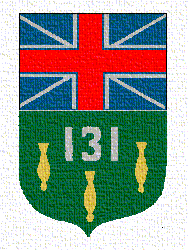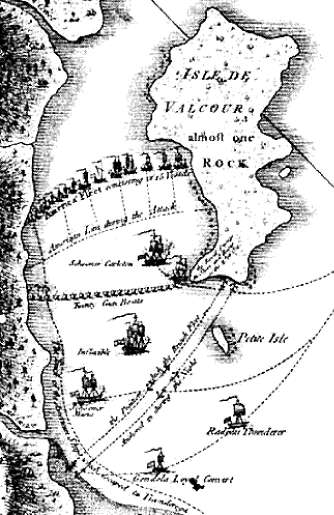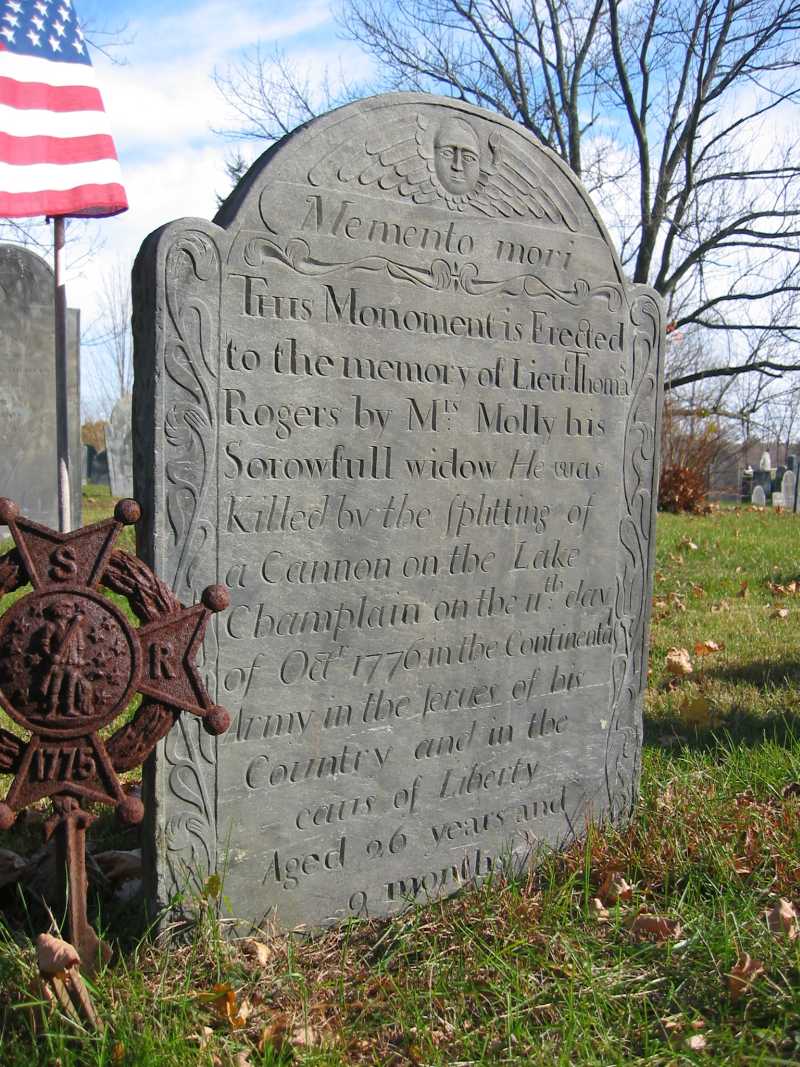 |

|
 |

|
Westford and the Battle of Valcour Island
In
1999, Edwin Scollon extended his arm into the fine silt at the bottom
of Lake Champlain and discovered a shattered cannon. That
discovery sparked the formation of the Valcour Bay Research Project (VBRP),
whose mission is to systematically search for historical artifacts from
the 1776 naval engagement between American Gen. Benedict Arnold’s
hastily constructed navy and Sir Guy Carleton’s British
fleet. Tireless research by George Quintal, Jr. led members of
the VBRP team to connect the fate of the cannon with that of two
Westford revolutionary war soldiers, Lt. Thomas Rogers and Sgt. Jonas
Holden.
The "moment in time" when the cannon exploded killed Rogers and injured
Holden. It was Holden's later pension records and a uniquely
descriptive and touching memorial stone erected by Rogers' widow,
Molly, at Westford's Fairview Cemetery, that would forge the historical
link between Westford's patriots and the many important artifacts that
have been discovered at the underwater archaeological site. The
remarkable connections between these events span more than two
centuries and bring to light the moving stories behind the sacrifice of
two Westford patriots and their families.
An exhibit entitled Rediscovering a Moment in Time was developed by the Lake Champlain Maritime Museum (LCMM). Highlighting
the efforts to map the underwater battlefield of what may have been the
most important naval engagement of the American War for Independence,
the exhibit features dozens of artifacts recovered in the summer of
2001,
including the shattered cannon. In recognition of the
intimate connection beween the events at Valcour Island and Westford's
patriots, the exhibit was offered to
the Westford Museum for
a
six month loan in November of 2004. Since the end of that tour,
the exhibit has been available for viewing at LCMM in Vergennes,
Vermont.
The work of the Valcour Bay Research Project is on-going, and the recovery and conservation of additional artifacts cataloged since 2001 is scheduled for the summer of 2006.
During the
colonial period, the inland waterways of
the Champlain and Hudson valleys provided a transportation route that
was vital
to the security of the northern colonies.
From the beginning of the Revolutionary War it was recognized
that
British control of the waterways would be disastrous to
 In the summer of
1776, aware of an imminent British naval incursion from
In the summer of
1776, aware of an imminent British naval incursion from
The lack of
experienced sailors forced
An anecdote from
Hodgman’s History of Westford
describes the scene as a group of 12 Westford soldiers departed for Ft.
Ticonderoga that year: “…one
of them,
Thomas Rogers, refused to stand up when [the Rev.] Mr. Thaxter spoke to
them,
…of the twelve all returned but Rogers.”
The British
military, under the command of General
Sir Guy Carleton, constructed their own fleet on the upper lake. In
contrast to
By
October of 1776,
A five-hour
battle ensued. As the crew of the
The
setting
sun ended the day’s contest. For the
Americans, 60 were killed or injured, two ships were lost, and 75% of
their
ammunition was expended. The British
suffered significant, though fewer losses, but were confident of
victory the
following day. Fully aware of his low
odds of success,
The following
day
The
looming winter caused the British to suspend their campaign until the
following spring. While the Battle of Valcour Island was a clear
British victory, the delay in the British advance caused by the
construction of Arnold’s fleet provided sufficient time for the
Americans to gather the means to win decisively at Saratoga the
following year, eliminating the British threat from the north.


The
signature of Thomas Rogers from the "Solemn League and Covenant."
Courtesy J.V. Fletcher Library
Molly Rogers was
pregnant when she learned of her
26-year-old husband’s death and would memorialize his sacrifice
for the “caus
of
In 1783, Molly, the “sorowfull
widow,” married William
Munroe, owner of the

Jonas Holden was
born in
Holden next
served during the 1776 campaign where
he joined the regiment of Col. Jonathan Reed, once again under Capt.
Joshua
Parker, this time promoted to sergeant.
It was at this time that he was detached to serve under
Following
subsequent service as an ensign under
Col. John Robinson of Westford during the
In total he
would serve for over 6 years.
After the war he
and his family emigrated from
Westford to various locations in
© 2004-2006 - D.P.
Lacroix

Last Updated 21 April, 2006
[Home ] [Site Index] [History ] [Today's Minutemen ] [Col. John Robinson Trail ] [Schedule ] [Pictures ] [Links & Resources ]